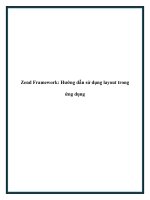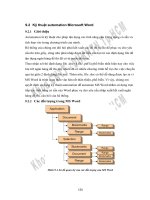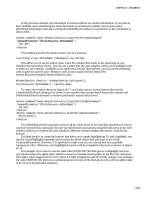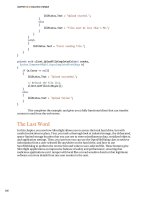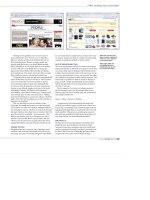pro zend framework techniques build a full cms project phần 10 potx
Bạn đang xem bản rút gọn của tài liệu. Xem và tải ngay bản đầy đủ của tài liệu tại đây (916.92 KB, 31 trang )
CHAPTER 11 ADVANCED TOPICS
216
} else {
$page = new CMS_Content_Item_Page($id);
}
// add a cache tag to this menu so you can update the cached menu
// when you update the page
$tags[] = 'page_' . $page->id;
$cache->save($page, $cacheKey, $tags);
}
$this->view->page = $page;
}
Now if you refresh the page (twice), the profiler will disappear. That is because it displays only when
there are queries to profile, and your application is now serving content without hitting the database.
Internationalization
It is becoming very common to have international teams of contributors working on a website together.
Many people standardize their applications to use common languages, but this can limit the reach of
your project.
Zend Framework supports many levels of internationalization. It gives you fine-grained control over
the locale and character sets it uses, for example. In this section, I will focus multilingual applications.
Getting Started with Zend_Translate
Zend_Translate makes translating your ZF projects much easier than using the native PHP functions. It
supports a range of source formats, has a very simple API, and tightly integrates with many ZF
components such as Zend_View and Zend_Form.
Zend_Translate_Adapters
The first thing you need to do is determine which adapter you want to use. The adapters are in the same
vein as those for Zend_Db_Table; they allow the common API to connect to a range of data sources.
In this example, you will use the CSV adapter. You can create the files with either a text editor or
most spreadsheet programs.
Integrating Zend_Translate with Your Project
There are many ways to integrate Zend_Translate with your project, but I prefer to create application
resources for any kind of generalized configuration like this. This enables you to reuse the resource in
any ZF project you work on.
To get started, create a new folder in the application folder named lang. Then create two files in
this folder: source-en.csv and source-es.csv.
Download at WoweBook.Com
CHAPTER 11 ADVANCED TOPICS
217
Note It is not technically necessary to create a language file for your default language. If the translate helper
does not locate a translation, it simply renders the text you pass it. I prefer to create one nonetheless because this
file serves as a template for people who want to translate the application into their language of choice.
The next step is to update your application.ini configuration file, adding the adapter you want to
use and the paths to your language files, as shown in Listing 11-15.
Listing 11-15. Adding the Translate Settings to application/configs/application.ini
resources.translate.adapter = csv
resources.translate.default.locale = "en_US"
resources.translate.default.file = APPLICATION_PATH "/lang/source-en.csv"
resources.translate.translation.es = APPLICATION_PATH "/lang/source-es.csv"
Now create a new file in library/CMS/Application/Resource named Translate.php. Create a new
class named CMS_Application_Resource_Translate that extends
Zend_Application_Resource_ResourceAbstract.
The translate application resource needs to create an instance of Zend_Translate, adding each of the
translation files with their appropriate locales. Then it registers the Zend_Translate instance in
Zend_Registry so the rest of the application can access it, as shown in Listing 11-16.
Listing 11-16. The Translation Application Resource in
library/CMS/Application/Resource/Translate.php
<?php
class CMS_Application_Resource_Translate extends Zend_Application_Resource_ResourceAbstract
{
public function init ()
{
$options = $this->getOptions();
$adapter = $options['adapter'];
$defaultTranslation = $options['default']['file'];
$defaultLocale = $options['default']['locale'];
$translate = new Zend_Translate($adapter, $defaultTranslation, $defaultLocale);
foreach ($options['translation'] as $locale => $translation) {
$translate->addTranslation($translation, $locale);
}
Zend_Registry::set('Zend_Translate', $translate);
return $translate;
}
}
Once this resource is configured, you are ready to start translating your interface. Translating the
front end is a very straightforward task; Zend_View has a translate() helper, which automatically fetches
the Zend_Translate instance from the registry. You simply pass the helper the string you want translated.
Download at WoweBook.Com
CHAPTER 11 ADVANCED TOPICS
218
In this example, I will just translate the headline on the search box; you can follow this lead and translate
the rest of the application.
Update application/layouts/scripts/layout.phtml, replacing the search box headline with the
code in Listing 11-17.
Listing 11-17. Translating the Search Box Headline in application/layouts/scripts/layout.phtml
<div id='searchForm'>
<h2><?php echo $this->translate('Search Site');?></h2>
<?php
$searchForm = new Form_SearchForm();
$searchForm->setAction('/search');
echo $searchForm->render();
?>
<br />
</div>
Next you need to add Search Site to the language files, as shown in Listings 11-18 and 11-19.
Listing 11-18. The Translated Search Headline in application/lang/source-en.csv
"Search Site"; "Search Site"
Listing 11-19. The Translated Search Headline in application/lang/source-es.csv
"Search Site"; "Busca Sitio"
Now your CMS will render this text in the proper language, which Zend_Translate will determine
based on the headers that the browser passes it.
Other Hidden Gems
Zend Framework has many other components that I do not have time to go over in this section. Some
are very specific to certain classes of applications, while there are many more that can be used in a wide
range of projects.
I learn something new every time I visit the Zend Framework site and recommend that you do the
same.
Summary
You started this chapter by learning how to fine-tune your project to perform as quickly as possible. You
stepped through profiling the application to identify bottlenecks. Then you optimized the core content
item class to resolve one of the largest issues.
Once this was done, you went on to set up the CMS cache. After caching several of the items, you
optimized the application to the point that it no longer queries the database at all for standard page
views.
Download at WoweBook.Com
CHAPTER 11 ADVANCED TOPICS
219
Next you learned about internationalization and set up your CMS to take advantage of
Zend_Translate.
The subject matter covered in this chapter could have easily filled entire books, but I hope it gave
you a taste of some of the lower-level features of the framework and provided a solid starting point for
you to start exploring on your own.
Download at WoweBook.Com
CHAPTER 11 ADVANCED TOPICS
220
Download at WoweBook.Com
C H A P T E R 1 2
■ ■ ■
221
Installing and Managing
a Site with Your CMS
In this chapter, I’ll cover how to install and manage a site with your CMS.
Creating the Database
The first step to install your CMS on your production server is to create the database. Therefore, create a
new database on your server using the MySQL command in Listing 12-1.
Listing 12-1. Creating the CMS Database
CREATE DATABASE cms_database
Once you create the database, you need to create a new user for the CMS database using the
command in Listing 12-2. On your local server, you may have used the root MySQL user, but this is a
critical security risk on a production database. Make sure you make a note of the user’s credentials,
because you will need to update the CMS configuration file when you install the application code base.
Listing 12-2. Creating the CMS Database User
CREATE USER 'cms_user'@'localhost' IDENTIFIED BY 'secret_password';
Grant the user permission to SELECT, INSERT, UPDATE, and DELETE on the cms_database database using
the command in Listing 12-3.
Listing 12-3. Granting the cms_user Access to the cms_database
GRANT SELECT,INSERT,UPDATE,DELETE ON cms_database.* TO 'cms_user'@'localhost';
Now you are ready to install the database. Over the course of this book, you have built the database
step-by-step, but when you install a new copy, it is more convenient to run a database dump script,
which will install the whole, empty database, as in Listing 12-4. The only data that this dump script
inserts is the default menus and the default site administrator account.
Download at WoweBook.Com
CHAPTER 12 ■ INSTALLING AND MANAGING A SITE WITH YOUR CMS
222
Listing 12-4. The Database Dump for the CMS Database
SET FOREIGN_KEY_CHECKS=0;
Table structure for content_nodes
DROP TABLE IF EXISTS `content_nodes`;
CREATE TABLE `content_nodes` (
`id` int(11) NOT NULL auto_increment,
`page_id` int(11) default NULL,
`node` varchar(50) default NULL,
`content` text,
PRIMARY KEY (`id`)
) ENGINE=InnoDB AUTO_INCREMENT=41 DEFAULT CHARSET=utf8;
Table structure for menu_items
DROP TABLE IF EXISTS `menu_items`;
CREATE TABLE `menu_items` (
`id` int(11) NOT NULL auto_increment,
`menu_id` int(11) default NULL,
`label` varchar(250) default NULL,
`page_id` int(11) default NULL,
`link` varchar(250) default NULL,
`position` int(11) default NULL,
PRIMARY KEY (`id`)
) ENGINE=InnoDB AUTO_INCREMENT=14 DEFAULT CHARSET=utf8;
Table structure for menus
DROP TABLE IF EXISTS `menus`;
CREATE TABLE `menus` (
`id` int(11) NOT NULL auto_increment,
`name` varchar(50) default NULL,
`access_level` varchar(50) default NULL,
PRIMARY KEY (`id`)
) ENGINE=InnoDB AUTO_INCREMENT=6 DEFAULT CHARSET=utf8;
Table structure for pages
DROP TABLE IF EXISTS `pages`;
CREATE TABLE `pages` (
`id` int(11) NOT NULL auto_increment,
`parent_id` int(11) default NULL,
`namespace` varchar(50) default NULL,
`name` varchar(100) default NULL,
`date_created` int(11) default NULL,
PRIMARY KEY (`id`)
Download at WoweBook.Com
CHAPTER 12 ■ INSTALLING AND MANAGING A SITE WITH YOUR CMS
223
) ENGINE=InnoDB AUTO_INCREMENT=11 DEFAULT CHARSET=utf8;
Table structure for users
DROP TABLE IF EXISTS `users`;
CREATE TABLE `users` (
`id` int(11) NOT NULL auto_increment,
`username` varchar(50) default NULL,
`password` varchar(250) default NULL,
`first_name` varchar(50) default NULL,
`last_name` varchar(50) default NULL,
`role` varchar(25) default NULL,
PRIMARY KEY (`id`)
) ENGINE=InnoDB AUTO_INCREMENT=2 DEFAULT CHARSET=utf8;
Records
INSERT INTO `menu_items` VALUES ('1', '1', 'Home', '0', '/', '1');
INSERT INTO `menu_items` VALUES ('2', '2', 'Manage Content', '0', '/page/list', '1');
INSERT INTO `menu_items` VALUES ('3', '2', 'Manage Menus', '0', '/menu', '2');
INSERT INTO `menu_items` VALUES ('4', '2', 'Manage Users', '0', '/user/list', '3');
INSERT INTO `menu_items` VALUES ('5', '2', 'Rebuild Search Index', '0',
'/search/build', '4');
INSERT INTO `menus` VALUES ('1', 'main_menu', null);
INSERT INTO `menus` VALUES ('2', 'admin_menu', null);
INSERT INTO `users` VALUES ('1', 'admin', '5f4dcc3b5aa765d61d8327deb882cf99', 'test',
'user', 'Administrator');
Installing the Application
Once your database is installed and configured, you are ready to install the application. Your directory
structure may depend on your server configuration, but in most hosting situations you will have a public
document root for your server named www or public_html. Upload all the files that are in your
application’s public directory into this directory.
Next you need to upload the application and library files. The application and library directories
should not be directly accessible by the public. Upload these directories to the root of your hosting
account, which should be next to the document root, as in Listing 12-5.
Listing 12-5. Standard Directory Structure for Your CMS
/ account root
/public_html
/application
/library
Download at WoweBook.Com
CHAPTER 12 ■ INSTALLING AND MANAGING A SITE WITH YOUR CMS
224
Alternate Installations
You can alternatively put your library and application directories in any location that is accessible by
your web server. Simply update your application, and include the paths in your index.php file.
Sharing One Common Library
If you are hosting this CMS on a dedicated server, you may want to be able to share a common Zend
Framework library. You can move the Zend directory from your application’s library to the directory
specified in your server’s PHP include path.
■ Note As the framework evolves, which is quite a rapid process, you may not want to be tied to using one
specific version of the framework. What I do is create subdirectories in the include directory like ZF_1_8. I then
add this to my include path in the
index.php file.
Configuring Your CMS
The only configuration that you will likely need to do to your CMS is to update the application.ini file
by updating the database connection information, as in Listing 12-6. I also turn the profiler off.
Listing 12-6. Setting Your Production Database Connection in application/configs/application.ini
resources.db.adapter = "pdo_mysql"
resources.db.params.host = "localhost"
resources.db.params.username = "cms_user"
resources.db.params.password = "secret_password"
resources.db.params.dbname = "cms_database"
resources.db.params.profiler = false
resources.db.isDefaultTableAdapter = true
Then set your application environment to production in .htaccess, as in Listing 12-7.
Listing 12-7. Setting the Application Environment in public_html/.htaccess
SetEnv APPLICATION_ENV production
Managing Users
Once your CMS is installed and configured, the first thing you should do is log in and update the admin
user account. The default database installation script (Listing 12-4) creates a user with the following
credentials:
Download at WoweBook.Com
CHAPTER 12 ■ INSTALLING AND MANAGING A SITE WITH YOUR CMS
225
• Username: admin
• Password: password
To get to the login page, click the link under My Account in the sidebar. Then go to /user/list. You
should see the user table, as in Figure 12-1.
Figure 12-1. The manage users page
Creating a User
You can either create a new user and delete the default user or just update the default user account. I will
create a new user. Click the “Create a new user” link beneath the user table. This will open the create
user form (see Figure 12-2). Create the user, and click Submit.
Download at WoweBook.Com
CHAPTER 12 ■ INSTALLING AND MANAGING A SITE WITH YOUR CMS
226
Figure 12-2. Creating a user account
Updating a User
To update a user account, click the Update link next to their name in the user table. The update user
form is virtually identical to the create user form, except there is no field to update the user’s password.
To update the user’s password, click the Update Password link below the Submit button.
Deleting a User
Once you have created your user account, you should delete the default account. Click the Delete link
next to the default user’s name in the user table.
Managing Content
Now that you have secured your CMS installation, you are ready to start working with content. Click the
Manage Content link on the sidebar to get started.
Download at WoweBook.Com
CHAPTER 12 ■ INSTALLING AND MANAGING A SITE WITH YOUR CMS
227
Creating a Page
When you click the Manage Content link, you will see a message that you do not have any pages yet.
Click the “Create a new page” link beneath this. This will open the page form (see Figure 12-3). Fill out
the page form, and click Submit to create it. Once your page is created, you will be directed back to the
page/list page. The page will now display a table with your new page in it.
Figure 12-3. The create page form
Updating a Page
When you need to update a page, you go to /page/list. Click the Update link next to the page that you
want to update. The update form will open (which is identical to the create page form). Make any
changes you need, and click Submit to save them.
Download at WoweBook.Com
CHAPTER 12 ■ INSTALLING AND MANAGING A SITE WITH YOUR CMS
228
Deleting a Page
To delete a page, click the Delete link next to the page name in the page list.
Navigating Between Pages
Now you need to add your new page to the site navigation. Click the Manage Menus link in the sidebar.
You will see a table with the current menus, as in Figure 12-4.
Figure 12-4. The manage menus page
Adding a Menu Item
To add your page to the main menu, click the Manage Menu Items link in the main_menu row. This will
open the menu items list for the main_menu. Click “Add a new item.” This will open the add item form
(see Figure 12-5).
There are two types of menu items: static links and direct links to existing pages. In this example,
you are adding a link to the page that you just created, so you select the page from the drop-down list.
Once you have done this, click Submit to create the menu item.
Download at WoweBook.Com
CHAPTER 12 ■ INSTALLING AND MANAGING A SITE WITH YOUR CMS
229
Figure 12-5. Adding a page to a menu
Sorting Menu Items
In this case, your new menu item will be inserted after the Home link, which is probably what you want.
When you do need to reorder a menu, you can do so in the Manage Menu Items table. You will notice
that there are Move Up and Move Down links next to the menu items (see Figure 12-6). Clicking these
will sort your menu items.
Download at WoweBook.Com
CHAPTER 12 ■ INSTALLING AND MANAGING A SITE WITH YOUR CMS
230
Figure 12-6. The Manage Menu Items list
Updating Menu Items
To update a menu item, go to the manage menu items page. Click the Update link next to the item that
you want to update. The update form will open, which is identical to the create menu item form.
Deleting Menu Items
To remove a menu item, go to the manage menu items page. Click the Delete link next to the item that
you want to remove.
The Next Steps
The CMS project I guided you through building in this book was very simplistic by design. I wanted to
focus on the underlying technologies rather than show you how to build the next best CMS solution. I
also think that the simpler software is, the easier it is to customize.
Over the course of this project, you learned how to work with many Zend Framework components.
Between this foundation of experience and the online Zend Framework resources, you should be well on
your way to becoming a proficient CMS developer.
Download at WoweBook.Com
231
Index
■A
abstract Content_Item class, 87, 91
creating base class, 87
extending base content item class, 92−3
loading pages, 88, 90
manipulating data, 91
overview, 87
utility methods, 90
abstract data structures, 77−8
abstraction layer, 87
access control, 164−5
action controllers, 12
add menu item action, 130
addAction(), 130
addAction() method, 131
addFilters() method, 43
adding
menu items, 228−9
addItem() method, 131
addMultiOptions() method, 45
addRole() method, 165
addValidators() method, 43
admin menus
creating, 139
rendering, 141
administrators, defined, 145
allow(), 165, 167
application
installing, 223−4
alternate installations, 224
configuring CMS, 224
sharing common library, 224
application folder, 8, 10, 15
action controllers, 12
application/configs/application.ini (default
application configuration) file, 11
Bootstrap class, 11
error handling, 13, 15
overview, 10
views, 12−3
Zend_Application, 10−1
application.ini file, 224
application/configs/application.ini (default
application configuration) file, 11
APPLICATION_ENV environmental variable, 9
APPLICATION_PATH envoronment variable, 9
authenticating users, 158, 163
logging users in, 159−60
logging users out, 161−2
overview, 158
user controls, adding to main interface, 162−3
user landing page, 159
author text control, 43
■B
Blues Skin, 31, 33
overview, 31
skin.xml file, 31
style sheets, 31, 33
Bootstrap class, 11, 34, 46
bug report form, 40, 51, 57, 74
completed, 48
controls, adding to, 42, 46
author text control, 43
date text control, 44
description text area control, 44
e-mail text control, 43
overview, 42−3
priority select control, 45
status select control, 45
submit button, 46
URL text control, 44
creating, 41−2
deleting bugs, 73−4
deleteAction(), 74
deleteBug() method, 74
overview, 73
filtering and sorting reports, 62, 66
fetchBugs() method, 63
filter form, 63−4
overview, 62
sort criteria, 65
getting started, 41
limiting and paginating bug reports using
Zend_Paginator, 66, 70
Download at WoweBook.Com
■ INDEX
232
fetchBugs() method, 66
listAction() method, 67−8
overview, 66
models, creating, 57
overview, 40, 57
processing, 48−9
rendering, 46−7
rendering bug reports, 68, 70
styling, 49, 51
submitting bugs, 57, 59
createBug() method, 57
overview, 57
submitAction() method, 58−9
table, creating, 54−5
updating bugs, 71, 73
edit view, 72
editAction() method, 71
overview, 71
updating record, 72−3
updating report form, 71
viewing all current bugs, 59, 62
fetchBugs() method, 59
list view, 60, 62
listAction() method, 60
overview, 59
BugController folder, 41
bugs table, 54−5
Button control, 38
■C
_callSetterMethod(), 88−9
Captcha control, 39
cascading
deletes, 87
updates, 87
Checkbox element, 39
clearIdentity() method, 161
CMS_Content_Item_Page class, 96
CMS data, 77, 93
content items, 87, 93
abstract Content_Item class, 87, 93
overview, 87
content nodes, 80, 82
content_nodes table, 80
ContentNode model class, 80, 82
overview, 80
data management system
implementing, 79−80
data structures, 77−8
abstract, 77−8
overview, 77
traditional, 77
database design, 78−9
overview, 77
pages, 82, 84
overview, 82
Page model class, 82, 84
pages table, 82
table relationships, 85, 87
cascading updates and deletes, 87
defining, 85−6
overview, 85
related items, 86
CMS database, 53, 55
bugs table, 54−5
configuring connection, 53−4
creating, 53
overview, 53
CMS databases
designing, 78−9
confirmationAction(), 59
content items, 87, 93
abstract Content_Item class, 87, 91
creating base class, 87
extending base content item class, 92−3
loading pages, 88, 90
manipulating data, 91
overview, 87
utility methods, 90
overview, 87
Content_Item class
abstract, 87, 91
creating base class, 87
extending base content item class, 92−3
loading pages, 88, 90
manipulating data, 91
overview, 87
utility methods, 90
content management, 95, 112
deleting pages, 105
editing pages, 103−4
opening page for, 103−4
overview, 103
updating pages, 104
managing pages, 101, 103
overview, 95
page content item class, 95−6
page controller, 97
page form, 97, 101
inserting pages, 100−1
overview, 97−8
rendering, 98−9
rendering pages, 105, 111
home page, 105, 110
opening page, 110−1
overview, 105
content nodes, 78−
80, 82
con
tent_nodes table, 80
content_nodes to pages relationship, 85
Download at WoweBook.Com
■ INDEX
233
ContentNode model class, 80, 82
creating content nodes, 81
deleting content nodes, 82
overview, 80
updating content nodes, 81
overview, 80
content segment, 28
content, site
creating page, 227
deleting page, 228
updating page, 227
controller response
rendering with Zend_Layout, 28−9
create a new page link, 227
create action command, 98, 117
create controller command, 115
create menu page, 119
create project command, 6
create user form
completed, 149
creating, 147−8
processing, 149−50
rendering, 148
createAction() method, 99, 101, 117, 120, 148, 150
createBug() method, 58
creating, 57
createElement() method, 43−4
createMenu(), 119
createRow() method, 83
createUser method, 149
CSS cascade, 31
css subfolder, 10
CSS-based layout, 22, 24
■D
data management, 53, 75
bug report form, 57, 74
deleting bugs, 73, 74
filtering and sorting reports, 62, 66
limiting and paginating bug reports using
Zend_Paginator, 66, 70
overview, 57
submitting bugs, 57, 59
updating bugs, 71, 73
viewing all current bugs, 59, 62
CMS database, 53, 55
bugs table, 54−5
configuring connection, 53−4
creating, 53
overview, 53
models, 55, 57
creating, 57
overview, 55−6
overview, 53
data management system
implementing, 79−80
data structures, 77−8
abstract, 77−8
overview, 77
traditional, 77
database, creating, 221, 223
database dump script, 221
Database table authentication adapter, 158
date text control, 44
DbTableSelect adapter, 66
decorators, 38
default user account, 225
Delete link, 226
delete() method, 56, 91
deleteAction(), 126
deleteAction() method, 74, 137−8
deleteBug() method, 74
deleteItem() method, 137
deleteMenu() method, 126
deletePage() method, 84
deleting
bugs, 73−4
deleteAction(), 74
deleteBug() method, 74
overview, 73
cascading
deletes, 87
content nodes, 82
menu items, 137, 230
menus, 126
pages, 84, 105
users, 157−8
deny(), 167
deny() method, 165
description text area control, 44
development environment, 3, 6
overview, 3
Zend command-line tool, rapid application
development with, 5−6
Zend Server CE, installing, 3, 5
Digest authentication adapter, 158
direct links, 228
Directory Structure, standard
for CMS, 223
Doctype placeholder helper, 27
document root, setting, 7
dump script, database, 221
dynamic content
adding to layout, 28
dynamic head
adding with Zend_View placeholders, 27
■E
edit view, 72
editAction() method, 71, 73, 103, 124
Download at WoweBook.Com
■ INDEX
234
e-mail text control, 43
error handling, 13, 15
error submission form, 40, 52
errorAction(), 14
ErrorController class, 14
■F
fetchAll() method, 59
fetchBugs(), 67
fetchBugs() method, 60, 65
creating, 59
updating, 63, 66
fetchPaginatorAdapter(), 66
fetchRow() method, 59
File element, 39
filtering
bug reports, 62, 66
fetchBugs() method, 63
filter form, 63−4
overview, 62
sort criteria, 65
find() method, 56, 83
findDependentRowset(), 86
findDependentRowset() method, 127
findParentRow(), 86
form elements, 38, 40
custom, 40
overview, 38
Zend_Form_Element_Button, 38
Zend_Form_Element_Captcha, 39
Zend_Form_Element_Checkbox, 39
Zend_Form_Element_File, 39
Zend_Form_Element_Hash, 39
Zend_Form_Element_Hidden, 39
Zend_Form_Element_Image, 39
Zend_Form_Element_MultiCheckbox, 39
Zend_Form_Element_Multiselect, 39
Zend_Form_Element_Password, 39
Zend_Form_Element_Radio, 40
Zend_Form_Element_Reset, 40
Zend_Form_Element_Select, 40
Zend_Form_Element_Submit, 40
Zend_Form_Element_Text, 40
Zend_Form_Element_Textarea, 40
forms
see web forms, 38
■G
_getLastPosition(), 132
_getProperties(), 88
get_class() method, 88
get_class_vars() method, 88
getInnerRow(), 88
getItems(), 127
getMenus() method, 121
getRecentPages() method, 106
getValues() method, 38
GUIDs
setting for main menus, 139
■H
Hash element, 39
HeadLink placeholder helper, 27
HeadMeta placeholder helper, 27
HeadScript placeholder helper, 27
HeadStyle placeholder helper, 27
HeadTitle placeholder helper, 27
Hidden element, 39
home page, 105, 110
completed, 142
most recent pages, 106, 108
overview, 105
setting, 110
home page, with login/logout links, 164
.htaccess file, redirecting request with, 9
HTML page
creating base, 22, 25
■I
index.php file, 9
_initAutoload() method, 46
_initView() method, 34
_insert() method, 91
inserting pages, 100−1
image element, 39
images subfolder, 10
indexAction(), 12, 126−7, 136, 159
indexAction() method, 120−1
IndexController class, 12
init() function, 71
init() method, 42
initView() method, 139
insert() method, 56
installing
Zend Server CE, 3, 5
interface design, 19, 25
base HTML page, creating, 22, 25
mock-up, 21
organizing components, 19, 21
overview, 19
testing, 25
isChecked() method, 38−9
isPost() method, 48
isValid() method, 38, 49
■J-K
javascript subfolder, 10
Download at WoweBook.Com
■ INDEX
235
■L
layout(), 28
layout configuration option, 18
layout design, 26, 29
configuring application to use, 29
controller response, rendering with Zend_Layout,
28−9
creating, 26−7
dynamic content, adding, 28
dynamic head, adding with Zend_View
placeholders, 27
overview, 26
testing, 29
layoutPath configuration option, 18
LDAP authentication adapter, 158
library folder, 8, 10
limiting
bug reports, 66, 70
fetchBugs() method, 66
listAction() method, 67−8
overview, 66
list view, 60, 62
listAction(), 60
listAction() method, 60, 64−5, 67, 68, 102, 151
listing
current menus, 120, 122
menu items, 127−8
loading
update item form, 135
loadPageObject() method, 87
loadSkin() helper, 35
loadSkin() view helper, 33−5
logging users in, 159−60
logging users out, 161−2
loginAction(), 160
logoutAction(), 161
■M
main menus
creating, 139
rendering, 140
setting GUIDs, 139
main site menus, 139, 141
admin menus
creating, 139
rendering, 141
main menus
creating, 139
rendering, 140
setting GUIDs, 139
overview, 139
Manage Content link, 227
Manage Menu Items link, 228
Manage Menu Items table, 229
Manage Menus link, 228
menu item form, 118
creating, 129−30
processing, 131
rendering, 131
menu items, 126, 138
adding, 129, 131, 228−9
add menu item action, 130
menu item form, 129−31
overview, 129
deleting, 137, 230
listing, 127−8
overview, 126
sorting, 132, 134, 229−30
table, 113
updating, 135−6, 230
overview, 135
update item form, 135−6
menu() method, 139
menu to menu item relationship, 114
MenuItemController, 127
menus
creating, 116, 120
menu form, 116, 120
overview, 116
deleting, 126
listing current, 120, 122
main site, 139, 141
admin menus, 139, 141
main menus, 139, 140
overview, 139
menu controllers, 115−6
menu items, 126, 138
adding, 129, 131
deleting, 137
listing, 127−8
overview, 126
sorting, 132, 134
updating, 135−6
overview, 113, 115
rendering, 138−9
updating, 123, 125
moveAction() method, 134
moveDown() method, 132−3
moveUp() method, 132−3
MultiCheckbox element, 39
Multiselect element, 39
■N
$_name property, 57
navigating between pages, 228, 230
adding menu item, 228−9
deleting menu items, 230
Download at WoweBook.Com
■ INDEX
236
sorting menu items, 229−30
updating menu items, 230
NO_SETTER constant, 89
■O
Open ID adapter, 158
openAction(), 143
■P-Q
page content item class, 95−6
page controller, 97
page form, 97, 101
completed, 100
inserting pages, 100−1
overview, 97−8
rendering, 98−9
page management, 82, 84
deleting pages, 105
editing pages, 103−4
opening page for, 103−4
overview, 103
updating pages, 104
inserting pages, 100−1
loading pages, 88, 90
overview, 82, 101, 103
page content item class, 95−6
page controller, 97
page form, 97, 101
inserting pages, 100−1
overview, 97−8
rendering, 98−9
Page model class, 82, 84
creating pages, 83
deleting pages, 84
overview, 82
updating pages, 83−4
pages table, 82
rendering pages, 105, 111
home page, 105, 110
opening page, 110−1
overview, 105
user landing page, 159
Page model class, 82, 84
creating pages, 83
deleting pages, 84
overview, 82
updating pages, 83−4
page to parent page relationship, 85−6
page-to-page relationship, 85
pages table, 82
pages, navigating between, 228, 230
adding menu item, 228−9
deleting menu items, 230
sorting menu items, 229−30
updating menu items, 230
paginating
bug reports, 66, 70
fetchBugs() method, 66
listAction() method, 67−8
overview, 66
pagination controls, 68, 70
paginationControl() helper, 69
partialLoop helper, 152
partialLoop() helper, 60, 102, 121, 127, 151
partialLoop() method, 69
partialLoop() view helper, 102
Password element, 39
.phtml file extension, 12
preDispatch(), 166−7
presentation layer, rendering
with Zend_Layout, 18
by itself, 18
overview, 18
Zend_Layout MVC, 18
with Zend_View, 17
overview, 17
view helpers, 17
view scripts, 17
priority select control, 45
processing
create user form, 149−50
menu form, 119−20
menu item form, 131
u
pdate item form, 136
processing forms, 38, 48−9
projects
anatomy of, 8, 15
application folder, 10, 15
library folder, 10
overview, 8
public folder, 9−10
creating
overview, 6
with Zend Tool Framework, 6
security, 165, 168
testing, 7
public directory, 223
public folder, 8−10
.htaccess file, redirecting request with, 9
index.php file, 9
overview, 9
subfolders of, 10
■R
Radio element, 40
_referenceMap property, 85
Download at WoweBook.Com
■ INDEX
237
render() method, 38
renderAction(), 138
renderAction() method, 142
rendering
admin menus, 141
bug reports, 68, 70
create user form, 148
main menus, 140
menu form, 117−8
menu item form, 131
menus, 138−9
page form, 98−9
pages, 105, 111
home page, 105, 110
opening pages, 110−1
overview, 105
update item form, 136
rendering forms, 38, 46−7
request-%)isPost() function, 150
Row Data Gateway pattern, 2
■S
save() method, 56, 91−2
search engine optimization (SEO), 142
security, 145, 169
access control, 164−5
overview, 145
project, 165, 168
user management, 145, 158
authenticating, 158, 163
creating new user, 146, 150
deleting users, 157−8
managing existing users, 151, 153
overview, 145
updating users, 154, 157
user data, 146
user model, 146
Select element, 40
select() object, 127
SEO-friendly URLs, 142, 144
setNode() method, 81
site design, 17, 36
interface, 19, 25
base HTML page, creating, 22, 25
mocking up, 21
organizing components, 19, 21
overview, 19
testing design, 25
layout, 26, 29
configuring application to use, 29
controller response, rendering with
Zend_Layout, 28−9
creating, 26−7
dynamic content, adding, 28
dynamic head, adding with Zend_View
placeholders, 27
overview, 26
testing design, 29
overview, 17
skin, 30, 35
Blues Skin, 31, 33
composition of, 30
loadSkin() view helper, 33−5
overview, 30
testing, 35
views, three-step approach, 18
Zend_Layout, rendering presentation layer with, 18
by itself, 18
overview, 18
Zend_Layout MVC, 18
Zend_View, rendering presentation layer with, 17
overview, 17
view helpers, 17
view scripts, 17
site navigation, 113, 144
creating menus, 116, 120
menu form, 116, 120
overview, 116
deleting menus, 126
listing current menus, 120, 122
main site menus, 139, 141
admin menus, 139, 141
main menus, 139−40
overview, 139
menu controllers, 115−6
menu items, 126, 138
adding, 129, 131
deleting, 137
listing items, 127−8
overview, 126
sorting, 132, 134
updating, 135−6
menu management, 113, 115
overview, 113
rendering menus, 138−9
SEO-friendly URLs, 142, 144
updating menus, 123, 125
site, installing and managing, 221, 230
creating database, 221, 223
installing application, 223−4
alternate installations, 224
configuring CMS, 224
sharing common library, 224
managing content
creating page, 227
deleting page, 228
updating page, 227
managing users, 224, 226
creating user, 225−6
deleting user, 226
Download at WoweBook.Com
■ INDEX
238
updating user, 226
navigating between pages, 228, 230
adding menu item, 228−9
deleting menu items, 230
sorting menu items, 229−30
updating menu items, 230
skin design, 30, 35
Blues Skin, 31, 33
overview, 31
skin.xml file, 31
style sheets, 31, 33
composition of, 30
loadSkin() view helper, 33−5
overview, 30
testing, 35
skin.xml file
Blues Skin, 31
skins, 18
skins subfolder, 31
sorting
bug reports, 62, 66
fetchBugs() method, 63
filter form, 63−4
overview, 62
sort criteria, 65
menu items, 132, 134, 229−30
static links, 228
status select control, 45
style sheets
Blues Skin, 31, 33
submit button, 46
submitAction(), 49, 58
method, 46
updating, 58−9
submitting
bugs, 57, 59
createBug() method, 57
overview, 57
submitAction() method, 58−9
■T
Table Data Gateway pattern, 2
table relationships, 85, 87
cascading updates and deletes, 87
defining, 85−6
content node to page relationship, 85
overview, 85
page to parent page relationship, 85−6
overview, 85
related items, 86
testing
interface, 25
layout, 29
projects, 7
skin, 35
Text element, 40
Textarea element, 40
thank-you page, 59
the create action command, 74
the Update Password link, 226
toArray() method, 71, 90, 103
traditional data structures, 77
■U
update item form
loading, 135
processing, 136
rendering, 136
Update link, menu items, 230
_update() method, 56, 91
update user action, 154
updating
bugs, 71, 73
edit view, 72
editAction() method, 71
overview, 71
updating record, 72−3
updating report form, 71
cascading
updates, 87
content nodes, 81
menu items, 135−6, 230
overview, 135
update item form, 135−6
menus, 123, 125
pages, 83−4, 104
users, 154, 157
updateAction(), 136
updateAction() method, 123, 154
updateBug() method, 72
updateItem() method, 136
updateMenu() method, 124
updatePage() method, 83
updatePassword() method, 156
updateUser() method, 154
URL text control, 44
URLs
SEO-friendly, 142, 144
user controller, 146−7
user controls
adding to main interface, 162−3
user-defined fields, 78
user landing page, 159
user model, 146
users, 145, 158, 224, 226
authenticating, 158, 163
logging users in, 159−60
logging users out, 161−2
Download at WoweBook.Com
■ INDEX
239
overview, 158
user controls, adding to main interface, 162−3
user landing page, 159
creating, 146, 150, 225−6
create user form, 147−50
overview, 146
user controller, 146−7
defined, 145
deleting, 157−8, 226
existing, 151, 153
overview, 145
updating, 154, 157, 226
user data, 146
user model, 146
utility methods
abstract, 90
■V
view helpers, 17
view scripts, 17
viewing
all current bugs, 59, 62
fetchBugs() method, 59
list view, 60, 62
listAction() method, 60
overview, 59
views, 12−3
three-step approach, 18
■W
web forms, 37, 52
anatomy of, 37
bug report form, 40, 51
controls, adding to, 42, 46
creating, 41−2
getting started, 41
overview, 40
processing, 48−9
rendering, 46−7
styling, 49, 51
form elements, 38, 40
custom, 40
overview, 38
Zend_Form_Element_Button, 38
Zend_Form_Element_Captcha, 39
Zend_Form_Element_Checkbox, 39
Zend_Form_Element_File, 39
Zend_Form_Element_Hash, 39
Zend_Form_Element_Hidden, 39
Zend_Form_Element_Image, 39
Zend_Form_Element_MultiCheckbox, 39
Zend_Form_Element_Multiselect, 39
Zend_Form_Element_Password, 39
Zend_Form_Element_Radio, 40
Zend_Form_Element_Reset, 40
Zend_Form_Element_Select, 40
Zend_Form_Element_Submit, 40
Zend_Form_Element_Text, 40
Zend_Form_Element_Textarea, 40
overview, 37
processing, 38
rendering, 38
wireframes, 21
■X-Y
XHTML forms, 37
■Z
Zend command-line tool
rapid application development with, 5−6
Zend Framework MVC implementation, 1, 3
overview, 1−2
Zend_Controller_Front, 2
Zend_Db, 2
Zend_View, 3
Zend Framework welcome page, 7−8
Zend Server Windows installer, 4
Zend Server CE
installing, 3, 5
Zend Tool Framework
creating projects with, 6
Zend_Acl, 145, 164−5
Zend_Acl_Role, 165
Zend_Application, 10−1
Zend_Application_Resource_Db, 54
Zend_Application_Resource_Frontcontroller, 110
Zend_Auth, 145, 158, 163
logging users in, 159−60
logging users out, 161−2
overview, 158
user controls, adding to main interface, 162−3
user landing page, 159
Zend_Controller, 1
Zend_Controller_Dispatcher_Interface, 2
Zend_Controller_Front, 2
Zend_Controller_Plugin_Abstract, 166
Zend_Controller_Request_Abstract, 2
Zend_Controller_Request_Http, 48
Zend_Controller_Response_Abstract, 2
Zend_Controller_Router_Interface, 2
Zend_Db, 2
Zend_Db_Select object, 56, 66
Zend_Db_Table, 2, 127
Zend_Db_Table_Abstract, 80
Zend_Db_Table_Abstract class, 56
Zend_Db_Table_Relationship, 114, 127
Download at WoweBook.Com
■ INDEX
240
Zend_Db_Table_Rowset, 59
Zend_Db_Table_Select object, 66
Zend_Form, 37, 52
anatomy of, 37
bug report form, 40, 51
controls, adding to, 42, 46
creating, 41−2
getting started, 41
overview, 40
processing, 48−9
rendering, 46−7
styling, 49, 51
form elements, 38, 40
custom, 40
overview, 38
Zend_Form_Element_Button, 38
Zend_Form_Element_Captcha, 39
Zend_Form_Element_Checkbox, 39
Zend_Form_Element_File, 39
Zend_Form_Element_Hash, 39
Zend_Form_Element_Hidden, 39
Zend_Form_Element_Image, 39
Zend_Form_Element_MultiCheckbox, 39
Zend_Form_Element_Multiselect, 39
Zend_Form_Element_Password, 39
Zend_Form_Element_Radio, 40
Zend_Form_Element_Reset, 40
Zend_Form_Element_Select, 40
Zend_Form_Element_Submit, 40
Zend_Form_Element_Text, 40
Zend_Form_Element_Textarea, 40
overview, 37
processing, 38
rendering, 38
Zend_Form_Element, 37
Zend_Form_Element_Button, 38
Zend_Form_Element_Captcha, 39
Zend_Form_Element_Checkbox, 39
Zend_Form_Element_File, 39
Zend_Form_Element_Hash, 39
Zend_Form_Element_Hidden, 39
Zend_Form_Element_Image, 39
Zend_Form_Element_MultiCheckbox, 39
Zend_Form_Element_Multiselect, 39
Zend_Form_Element_Password, 39
Zend_Form_Element_Radio, 40
Zend_Form_Element_Reset, 40
Zend_Form_Element_Select, 40
Zend_Form_Element_Submit, 40
Zend_Form_Element_Text, 40
Zend_Form_Element_Textarea, 40
Zend_Layout
controller response, 29
rendering controller response, 28
rendering presentation layer with, 18
by itself, 18
overview, 18
Zend_Layout MVC, 18
Zend_Layout MVC, 18
Zend_Loader_Autoloader, 42
Zend_Loader_Autoloader_Resource, 46
Zend_Paginator
limiting and paginating bug reports, 66, 70
fetchBugs() method, 66
listAction() method, 67−8
overview, 66
Zend_Tool, 41
Zend_Validate_Date() validator, 44
Zend_View, 1, 3
dynamic head, adding with placeholders, 27
rendering presentation layer with, 17
overview, 17
view helpers, 17
view scripts, 17
Zend_View_Helper_Abstract, 34
zf show version command, 5
zf.bat file, 6
zf.sh file, 6
Download at WoweBook.Com


